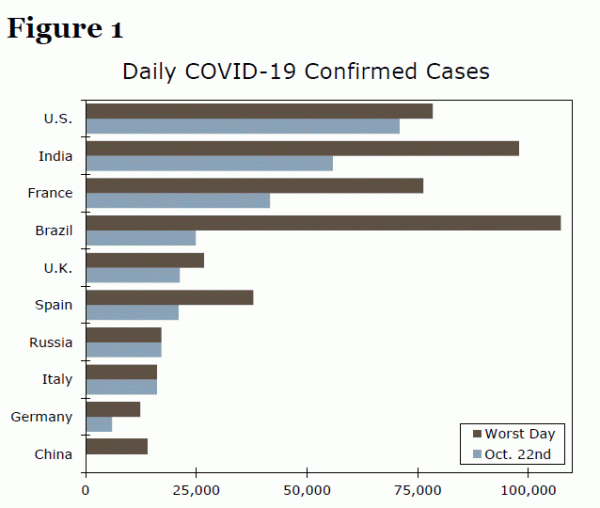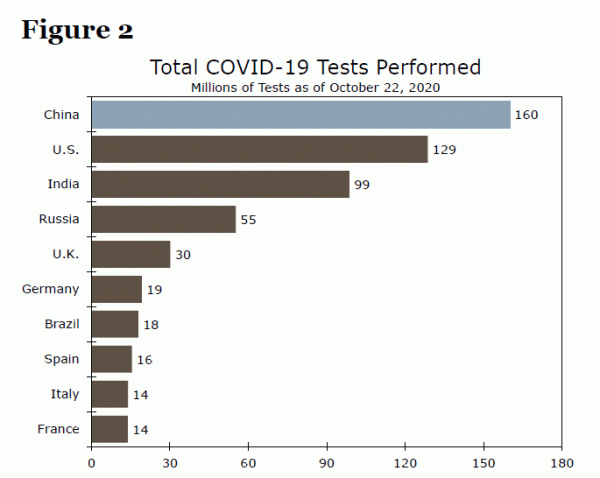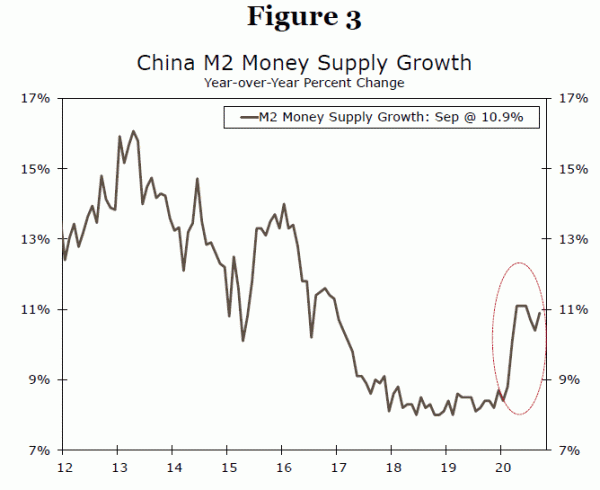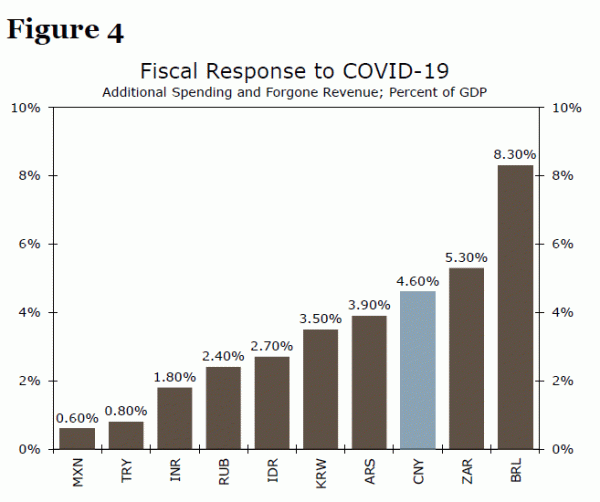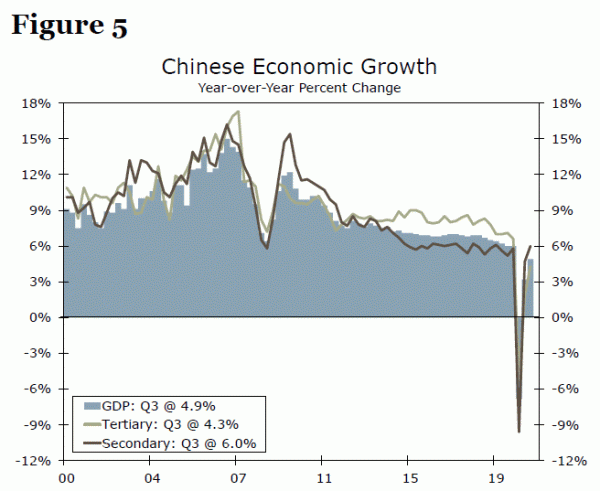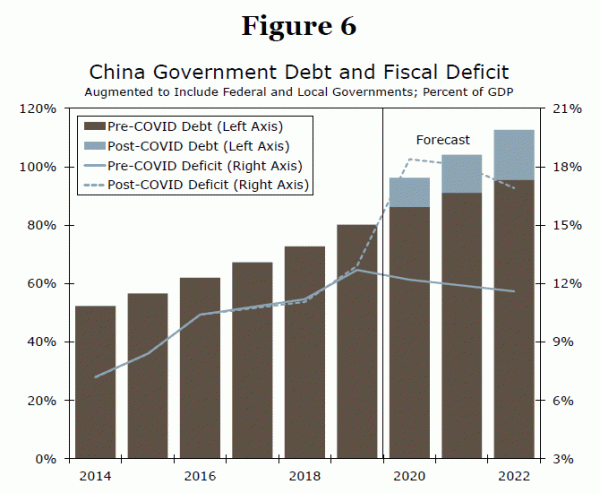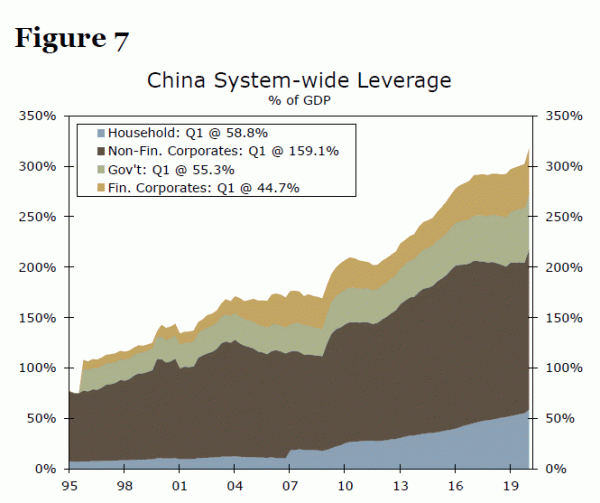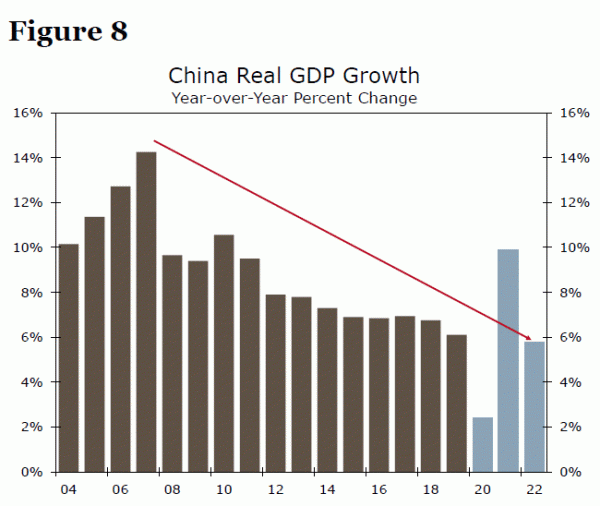Executive Summary
- China continues to lead the world in the containment of COVID as new confirmed cases are minimal. This apparent success can likely be attributed to early lockdown protocols, significant testing and other healthcare procedures designed to mitigate the spread of COVID, allowing for the economy to re-open faster than expected.
- In addition to virus containment, aggressive monetary and fiscal stimulus have been implemented and have been key to the pick-up in economic activity. The combination of virus containment and fiscal stimulus has resulted in China leading the global economic recovery and is reflected in upward revisions to our 2020 GDP forecast.
- Despite the V-shaped recovery, vulnerabilities are still accumulating as China’s economy is highly leveraged and stimulus measures may be losing effectiveness. In a post-COVID world, we expect “trend growth” to fall below the government’s 6% target as stimulus measures wind down to manage imbalances, and policy space diminishes.
- With broader market strains having calmed to some extent, market participants seem to be paying more attention to underlying economic fundamentals and political developments, which have supported China’s local financial markets and the renminbi.
Virus Containment Goes a Long Way…
For some time now, we have highlighted the outperformance of the Chinese economy. In our view, China is leading the global economic recovery from the COVID-induced downturn and is currently one of the only economic bright spots globally. There are reasons behind this outperformance, but perhaps the most important has been China’s containment of COVID. Despite the virus originating in China, local health authorities and policymakers have had success effectively managing the spread of the virus. To put virus containment in more context, Figure 1 compares major countries around the world and their fight against the spread of the virus. We compare each country’s worst day of confirmed cases (the day recorded cases went up the most) against where daily confirmed cases currently stand.
In China’s case, daily virus infections were at their worst in February with around 14,000 new reported cases. As of now, new cases across the country are essentially zero, which is impressive given the recent surge of confirmed cases around the world, especially in developed Europe and some emerging market countries. Countries such as Italy just recorded the most daily confirmed cases on record, while cases in the U.K., France, Spain and Germany have also hit new daily highs. In the emerging world, Brazil has seen daily confirmed cases drop significantly; however, Russia also reported the highest number of new daily infections on record this week. The fact China has been able to mitigate the spread of the virus has allowed the economy to re-open and for activity data to improve.
A large part of China’s ability to contain the virus likely comes from the sheer amount of COVID tests administered across the country (Figure 2). Recent data show China’s healthcare industry workers have performed 160M COVID tests, the most virus tests of any country in the world. The drop-off after China is steep, with the United States having conducted 129M COVID tests, about 30M fewer than China. Further down the list, emerging market countries with high amounts of confirmed cases and less developed healthcare infrastructure such as India, Russia and Brazil have not conducted anywhere near the amount of tests that China has. One might presume containment of the virus, or lack thereof, is at least partly correlated to the number of tests that have been conducted. In addition, China was also one of the first countries to institute lockdown and social distancing protocols, implement strict contact tracing procedures and adopt face coverings all as a way to halt the spread of the virus. Even as the economy has re-opened and factories come back online, China never experienced a “second wave” of infections the way developed Europe has recently or even the United States.
…While Supportive Policy Shapes a V-Recovery
As mentioned, the containment of the virus has allowed China’s economy to open up and essentially begin operating as normal once again. Factories are operating at pre-virus levels, while mobility across the country has also picked up as lockdown measures ease. But, in addition to virus containment, the Chinese economy has received massive policy support from the People’s Bank of China (PBoC) as well as the Chinese government. For monetary policy, the PBoC has taken multiple steps to make access to money easier and cheaper. Lending rates have come down, while liquidity has also been made more available. These actions have been most visible in the growth of money supply across China. M2 money supply growth slowed significantly earlier in the decade before flattening out in recent years. As the effects of the virus unfolded, growth in the M2 money supply increased sharply, evidence of more accommodative monetary policy (Figure 3).
Easier monetary policy has been paired with aggressive fiscal stimulus from the Chinese government as well. In terms of additional spending and forgone revenue, China has moved forward with a fiscal response to COVID worth a little more than 4.5% of GDP (Figure 4). Relative to other emerging market peer countries, China has implemented the most fiscal stimulus in emerging Asia, while only South Africa and Brazil have instituted larger fiscal responses among the emerging economies. The majority of the government’s additional spending is targeted to prevent the spread of the virus and support households via employment initiatives and basic living needs. These policies include extending social assistance programs for families falling into poverty and unemployment benefits for people that have lost jobs as a result of COVID. With respect to forgone revenue, the government has exempted VAT payments for goods and services related to controlling the virus as well as for small taxpayers in highly affected regions. VAT rates have also been lowered to 1% from 3% in these regions through the end of the year. In addition, local corporations in highly affected areas such as the Hubei province where Wuhan is located have been given tax relief and longer tax loss carryover provisions.
The re-opening of the economy along with supportive monetary and fiscal policy have been reflected in economic data over the last few quarters. Following a significant decline in Q1, GDP beat expectations in Q2, while activity and sentiment data have continued to improve. Early this week, we received Q3 GDP data, which revealed the economic rebound is still gathering momentum and remains uninterrupted in China. On a year-over-year basis, China’s economy expanded 4.9% in Q3, slightly lower than consensus forecasts as well as our estimates; however, still greater than the 3.2% year-over-year expansion in Q2 (Figure 5). The tertiary sector (i.e. wholesale and retail trade, financial sector, real estate, etc.) grew 4.3% year-over-year, while the secondary sector (i.e.: manufacturing, construction etc.) expanded 6% year-over-year in Q3.
As China’s economy continues to demonstrate resilience and outperform expectations, we have consistently revised our 2020 GDP forecast higher. Following the large contraction in Q1 and some indications of sluggish momentum in the immediate aftermath of the economic decline, we forecasted in our May forecast update that the Chinese economy would contract 1.2% this year. However, the combination of a quicker-than-expected virus containment, a swift re-opening of the economy, combined with forceful monetary and fiscal stimulus, have led us to revise our GDP forecasts higher over the last five months. As of our latest (mid-October) forecast, we estimate the Chinese economy will expand about 2.5% this year. Assuming our forecast is accurate, China will be the only major economy in the world to register positive economic growth in 2020.
Vulnerabilities Still Exist and Are Accumulating
Despite the Chinese economy leading the global economic recovery from COVID, vulnerabilities still exist. These vulnerabilities were prevalent pre-virus; however, COVID and the subsequent stimulus measures have arguably further exacerbated these vulnerabilities. In our view, one of the most glaring imbalances within the Chinese economy are the debt and fiscal dynamics of the Chinese government. To get a clearer and more accurate picture of the debt and fiscal position of the government, we use augmented statistics as published by the International Monetary Fund (IMF). Augmented statistics include not only the federal government, but also local government financing vehicles via the federal government, state-owned enterprises as well as other off-budget activities. Figure 6 indicates these debt and fiscal dynamics within China have been steadily deteriorating for some years. In 2014, augmented debt was about 50% of GDP, and the debt position has subsequently deteriorated. The IMF’s most recent pre-COVID forecast, with which we broadly concur, expects augmented debt to rise to about 85% of GDP by the end of 2020. The same can be said for China’s fiscal deficit, which was about 6% of GDP in 2014. The deficit has subsequently worsened, and the most recent pre-COVID forecast was for the deficit to widen to around 12% of GDP in 2020.
The trajectory of China’s debt and fiscal accounts were certainly worrisome pre-virus; however, the stimulus put forward in an effort to support the economy and offset the impact of COVID has made debt and fiscal dynamics far worse. In fact, our own estimates show China’s augmented debt burden could rise to around 100% of GDP by the end of the year and to reach close to 115% by 2022. In addition, the fiscal deficit could widen to over 18% of GDP by the end of the year and only slightly improve by 2022. Although the risk of sovereign default in China is very low, the evolution of China’s debt burden and its budget balance is becoming more concerning.
Elevated leverage is not just a government vulnerability, but an imbalance that is prevalent across China’s entire economy. An overleveraged economy was a problem pre-virus, and similar to the government, an issue that has become and will likely continue to get worse as a result of COVID. Looking at China’s entire system, debt across the economy is approaching 320% of GDP as of Q1 of this year (Figure 7). Most of the rise in leverage occurred in the aftermath of the 2008 financial crisis, in an effort to support the Chinese recovery. In fact, from Q1 2009 – Q1 2020 system-wide leverage rose 136 percentage points, a notable increase. Indeed, Q1 2020 saw a sharp rise, and we expect leverage to rise even further in subsequent quarters. Much of this leverage comes from China’s non-financial business sector, while household and financial sector leverage is more manageable. Accordingly, the non-financial business sector represents a specific vulnerability within China given the elevated debt burden across the sector. Over the years, corporate defaults outside of the financial sector have been widespread, although not to a point where systemic defaults likely would ensue.
What is also interesting is how the Chinese economy is now responding to the rise in leverage. For years, authorities have supported the economy via monetary and fiscal stimulus, inspiring a rise in lending and leverage. Despite stimulus and elevated system-wide borrowing, the Chinese economy has steadily decelerated since the Great Financial Crisis. In our view, this is a signal that stimulus measures are not having as significant an impact on the Chinese economy. Elevated fiscal spending during the current crisis could limit the government’s capacity to support the economy going forward, while monetary accommodation at present could also limit space for future monetary policy actions. If policy space is diminished and stimulus eventually winds down, compounded by an economy not responding to stimulus as it previously had, China’s “trend growth” rate is likely to slow. In that context, we believe China’s new trend growth rate will fall below the government’s 6% target in a post-COVID world. A return to trend growth will likely not occur until 2022; however, we believe growth will eventually settle around 5.8% (Figure 8).
Focus on the Fundamentals
China’s recovery and improved underlying fundamentals have supported China’s local financial markets, in particular the renminbi. China’s renminbi is already one of the best performing emerging market currencies this year, strengthening around 4.7% year-to-date against the U.S. dollar. With China’s economy likely to record positive GDP growth this year, a stark difference from many other emerging market economies, and geopolitical tensions not materially escalating, we believe investor sentiment towards China will remain positive through the end of the year and into 2021. Under the assumption that markets will focus on underlying economic fundamentals, we believe capital flows will continue to return to China and into renminbi-denominated assets.
Positive sentiment and capital flows have the potential to also support the renminbi over the longerterm. Chinese authorities have looked to make local equities and bonds more accessible to foreign investors, and authorities have made additional progress on this front over the course of the year. In September, the Financial Times Stock Exchange (FTSE) announced that it will include China bonds in its World Government Bond Index in 2021, which should attract more foreign investors to renminbi-denominated assets. In addition, as of June 2020 all three major equity index providers—FTSE, MSCI and S&P—include China A shares in their emerging markets indices. China A shares are equities listed in Shanghai or Shenzen and traded in renminbi, while each of these providers have recently increased the weight of China holdings in their indices.
We believe Chinese authorities will continue making local assets more accessible to international investors. In our view, Chinese policymakers wish to have the renminbi play a larger role in the global economy. One way to make the renminbi more important on the global stage is to open up China’s economy and financial markets to foreign investors. As this process unfolds, China should become an attractive long-term destination for foreign capital flows. In addition, Chinese authorities may eventually ease up on capital controls and allow the currency to float more freely. Easing these restrictions should also make investors more comfortable taking on renminbi risk. While easing capital controls and allowing a free floating currency could support the renminbi, these measures are likely to materialize over the very long-term (potentially decades).
While strong underlying fundamentals and increased capital flows have supported the renminbi over the course of the year, Chinese authorities could very easily decide to halt, or at least temporarily disrupt, the recent appreciation trend of the currency. The PBoC could opt to set the daily fix of the renminbi much weaker or directly intervene in FX markets and sell renminbi in an effort to enhance the competiveness of China’s export sector.
Finally, there is still a risk that U.S.-China tensions escalate to a point where sentiment turns against the renminbi. However, the renminbi has brushed off recent attempts at escalation from the Trump administration, and with two weeks to go to the U.S. presidential election, we believe time to rally President Trump’s base supporters via the “hard line on China” approach is probably running out. In the event trade tensions heat up again and additional tariffs become a likely possibility, the renminbi could reverse course and come under some pressure; however, additional tariffs are not included in our base case for China or the global economy at this time.




